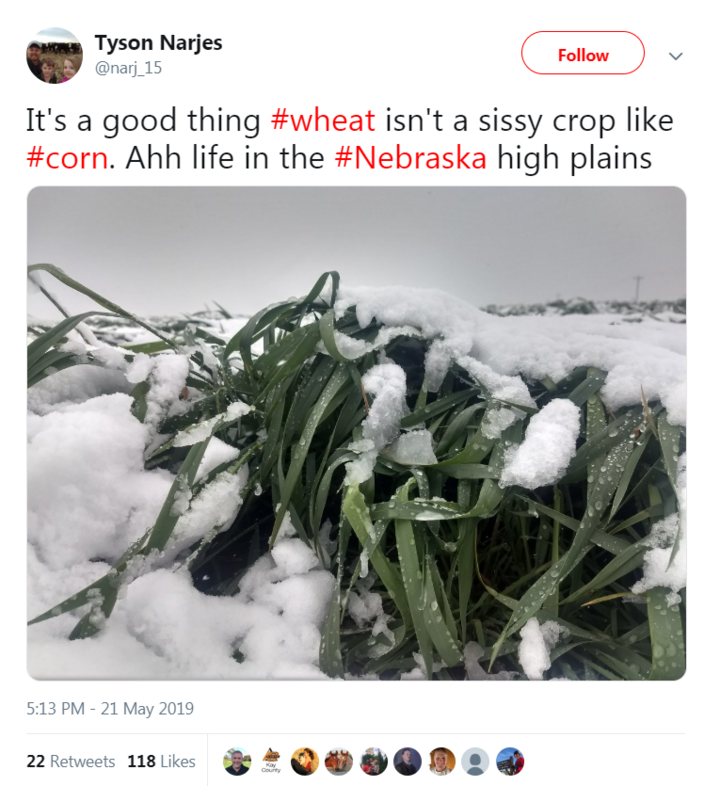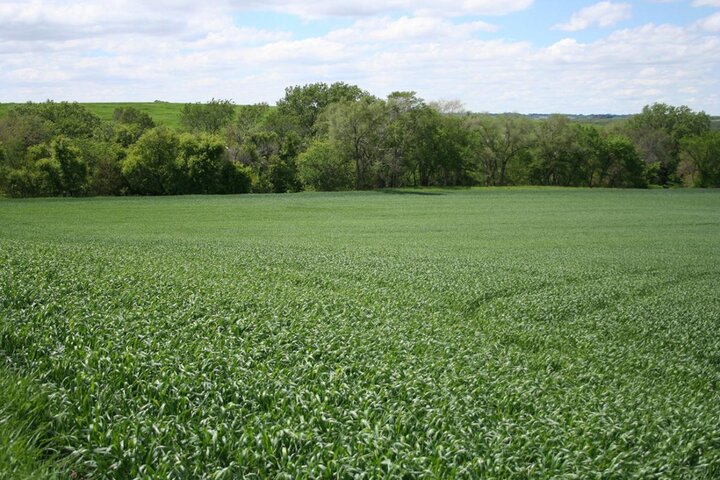Wheat growth is running 7-10 days behind normal across much of the state, which may push the grain-fill period into some of the hottest days of the wheat season. While there appears to have been little injury from the snow and cold temperatures in the Panhandle earlier in the week, current cool wet conditions are conducive to the development of wheat diseases.
Following are reports on wheat growth and condition from three Nebraska regions.
Panhandle

Cody Creech, Dryland Crops Specialist, and John Thomas, Extension Educator: Wheat in the Nebraska Panhandle was almost completed tillered and starting to elongate when it received 1-3 inches of snow Tuesday, May 21. Much of the Panhandle saw freezing or near freezing temperatures, but it doesn’t appear to have caused significant damage to the wheat crop, which is 7-10 days behind normal development. Had growth been more advanced, the snow and freezing temperatures could have caused significant damage. The snow followed hailstorms that moved through areas of the Panhandle Friday night, causing major damage near Sidney. Some of this hail damage may not become apparent until after the head emerges, when problems such as buggy-whipped heads will become visible.
If temperatures had dropped to 30°F or below for several hours, freeze damage would be expected. If it had dropped below 28°F, freeze injury could be critical.
Overall, wheat condition in the Panhandle is good, with little or no disease and above average moisture. There is concern, however, that continued cool, wet conditions could lead to increased disease pressure. Growers should be scouting fields now, especially the lower leaves of wheat plants, looking for disease symptoms. There is some concern that the delay in growth stage will push the critical grain fill stage into the hottest days of summer.
Late May is also when wheat stem sawflies become apparent. Extension Entomologist Jeff Bradshaw is monitoring for them in the Panhandle, but none have been found. The delay in GDD accumulation that affects wheat growth also affects this pest.
Southwest
Robert Klein, Emeritus Extension Professor: Most fields are in excellent condition with good soil water and good yield potential and expected to start heading within the week. Before this week’s rains, some winter wheat was showing signs of stress from lack of soil water. Apparently, the crop had not rooted down deep enough, but ample rains this past week have eliminated the stress. Growth stage is as much as two weeks behind normal, which protected it from freeze injury, but will mean it's likely to be subject to higher temperatures during the filling period. This shortens the filling period and reduces yields. Any daily temperature over 85°F can reduce wheat yields.
For most of Nebraska the coldest overnight temperatures this month were May 2 and 3. Low temperatures also occurred on May 10 and 11 and at Wallace (25°F) and Bushnell (26°F) on May 22. The winter wheat in southwest Nebraska on May 2 and 3 was in the joint stage and could have been damaged by temperatures of 24°F and lower. Plants subjected to two hours at that temperature likely will be injured. (For additional information, see Assessing Freeze Injury to Winter Wheat.)
The region did have temperatures cold enough for long enough to cause freeze injury, but the microclimate kept the temperatures above those levels.
Disease levels are very low. Some fields have been sprayed with a fungicide to protect the flag leaf. Continue scouting the fields to evaluate if a fungicide application is warranted.
South Central and Southeast


Michael Sindelar, Extension Educator in Nuckolls and Clay Counties: Wheat ranges from beginning flowering in early planted wheat to pre-flag leaf in late planted wheat. In Clay County, minor damage due to powdery mildew has been observed. Bird cherry aphids (Rhopalosiphum padi) have been found in Nuckolls County. (See NebGuide G1284, Cereal Aphids for more information.) The stands across the counties range from good to fair. Due to the wet spring and frequent rains, this area is at risk for developing wheat head scab and leaf rust. Additionally, signs of leaf rust have been found in Nuckolls county. With the risk of leaf rust and head scab, fungicide applications in wheat may be needed to safeguard yields. However, at the current price of wheat, a fungicide treatment for non-contracted wheat may not be profitable.
Nathan Mueller, Extension Educator serving Dodge and Washington Counties: Winter wheat is in mostly good condition with a full soil moisture profile going into heading. As of May 22, growth stages ranged from Feekes 7 to Feekes 10 due to variation in planting dates and variety selection. Weed pressure was light in fields this year, with only about 75% of the acres being sprayed using either Huskie or Affinity Broadspec with 2,4-D. Disease pressure is currently very low, but there will be a higher risk of Fusarium head blight given the wet conditions and forecast. The UNL variety trial in Washington County looks great and you can clearly see the expression of the different varieties now (Figure 2).
Megan Taylor, Extension Educator serving Platte, Boone and Nance Counties: Wheat in this area is in the booting stage to heading stages. The biggest concerns have been the freezing stress that occurred two weeks ago. Many wheat fields in my area are grown on particularly challenging terrain, in those low areas is where most of the damage is. Even the heads that hadn’t emerged from the leaf sheath were still at risk. There are some c-shaped wheat heads that have emerged due to the freezing stress. There is also leaf bleaching on the flag leaf. Wheat fields affected by the flooding are still progressing and many will be used for forage sources or as a means to hold loose sediment deposited. There have been no signs of insect or disease pressure within my area in wheat, so far. Producers leaving the wheat for grain are keeping their eyes peeled for possible fusarium symptoms. This may become difficult to differentiate between freeze and disease.

